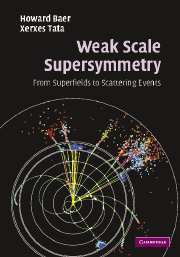Book contents
- Frontmatter
- Contents
- Preface
- 1 The Standard Model
- 2 What lies beyond the Standard Model?
- 3 The Wess–Zumino model
- 4 The supersymmetry algebra
- 5 Superfield formalism
- 6 Supersymmetric gauge theories
- 7 Supersymmetry breaking
- 8 The Minimal Supersymmetric Standard Model
- 9 Implications of the MSSM
- 10 Local supersymmetry
- 11 Realistic supersymmetric models
- 12 Sparticle production at colliders
- 13 Sparticle decays
- 14 Supersymmetric event generation
- 15 The search for supersymmetry at colliders
- 16 R-parity violation
- 17 Epilogue
- Appendix A Sparticle production cross sections
- Appendix B Sparticle decay widths
- Appendix C Higgs boson decay widths
- Bibliography
- Index
1 - The Standard Model
- Frontmatter
- Contents
- Preface
- 1 The Standard Model
- 2 What lies beyond the Standard Model?
- 3 The Wess–Zumino model
- 4 The supersymmetry algebra
- 5 Superfield formalism
- 6 Supersymmetric gauge theories
- 7 Supersymmetry breaking
- 8 The Minimal Supersymmetric Standard Model
- 9 Implications of the MSSM
- 10 Local supersymmetry
- 11 Realistic supersymmetric models
- 12 Sparticle production at colliders
- 13 Sparticle decays
- 14 Supersymmetric event generation
- 15 The search for supersymmetry at colliders
- 16 R-parity violation
- 17 Epilogue
- Appendix A Sparticle production cross sections
- Appendix B Sparticle decay widths
- Appendix C Higgs boson decay widths
- Bibliography
- Index
Summary
The 1970s witnessed the emergence of what has become the Standard Model (SM) of particle physics. The SM describes the interactions of quarks and leptons that are the constituents of all matter that we know about. The strong interactions are described by quantum chromodynamics (QCD) while the electromagnetic and the weak interactions have been synthesized into a single electroweak framework. This theory has proven to be extremely successful in describing a tremendous variety of experimental data ranging over many decades of energy. The discovery of neutral currents in the 1970s followed by the direct observation of the W and Z bosons at the CERN SpS collider in the early 1980s spectacularly confirmed the ideas underlying the electroweak framework. Since then, precision measurements of the properties of the W and Z bosons at both e+e− and hadron colliders have allowed a test of electroweak theory at the 10−3 level. QCD has been tested in the perturbative regime in hard collision processes that result in the breakup of the colliding hadrons. In addition, lattice gauge calculations allow physicists to test non-perturbative QCD via predictions for the observed properties of hadrons for which there is a wealth of experimental information.
Gauge invariance
One of the most important lessons that we have learned from the SM is that dynamics arises from a symmetry principle. If we require the Lagrangian density to be invariant under local gauge transformations, we are forced to introduce a set of gauge potentials with couplings to elementary scalar and fermion matter fields that, apart from an overall scale, are completely determined by symmetry principles.
- Type
- Chapter
- Information
- Weak Scale SupersymmetryFrom Superfields to Scattering Events, pp. 1 - 10Publisher: Cambridge University PressPrint publication year: 2006
- 1
- Cited by



